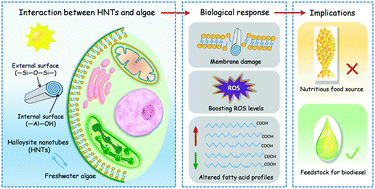Cellular response of freshwater algae to halloysite nanotubes: alteration of oxidative stress and membrane function†
Abstract
Halloysite nanotubes (HNTs) are a low-cost clay nanomaterial that has received an increasing amount of attention for applications in various fields. The use of HNT-containing products inevitably leads to their release into aquatic environments. However, the biological effects of HNTs on aquatic organisms remain poorly understood. This study investigated the potential effects of HNTs on model freshwater alga Chlorella vulgaris at the tissue, cellular, and subcellular levels and compared the effects with those of HNTs' main constituents: nSiO2, nAl2O3, and a mixture of nSiO2 and nAl2O3. The results revealed that these tested nanomaterials inhibited algal growth in a dose-dependent manner and the inhibition capacity followed the trend nAl2O3 > HNTs ≈ nSiO2 + nAl2O3 > nSiO2. However, exposure to HNTs triggered greater levels of reactive oxygen species (ROS) than exposure to the nSiO2 + nAl2O3 mixture without significantly changing enzyme activity. Surface and ultrastructural observations combined with flow cytometry supported the hypothesis that the nanotubular structure of HNTs impaired membrane integrity and induced overproduction of ROS. A fatty acid (FA) profile analysis suggested that the increase in monounsaturated FAs such as C17:1 and C18:1/n-9 may alter the cell membrane fluidity under HNT exposure. Cell defense to HNTs was mediated by the FA saturation degree or the activity of FA desaturase. This study provides novel insights into the environmental safety of HNTs in aquatic ecosystems.



 Please wait while we load your content...
Please wait while we load your content...